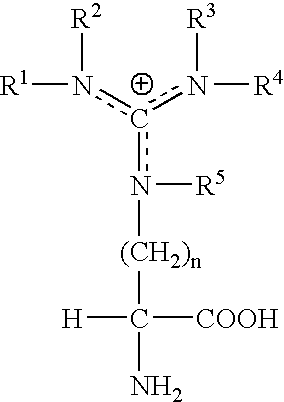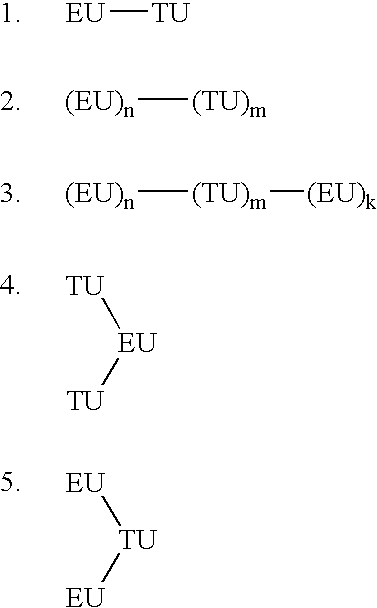Tumor targeting agents and uses thereof
a technology of tumor targeting and tumors, applied in the field of tumor targeting agents, can solve the problems of requiring a huge number of lives every year, limited treatment methods of cancer, and rare curative treatmen
- Summary
- Abstract
- Description
- Claims
- Application Information
AI Technical Summary
Benefits of technology
Problems solved by technology
Method used
Image
Examples
example 1
SYNTHESIS OF TARGETING MOTIF / TARGETING UNIT (PEPTIDE) IRE. THE USE OF A PEPTIDE SYNTHESIS RESIN WITH NO AMINO ACID RESIDUE PRE-COUPLED TO IT, AND DERIVATIZATION OF SUCH A RESIN WITH A PROTECTED AMINO ACID DERIVATIVE (RESIDUE)
[0372] The synthesis of the targeting motif / targeting unit (peptide) IRE (isoleucyl-arginyl-glutamine) was performed by using the manual solid-phase peptide synthesis technique that is described in detail in Example 2 below.
[0373] The coupling (binding) of the first amino acid unit (residue) to the hydroxyl groups of a peptide synthesis resin (HMP type; for details, see the listing of materials given below) was carried out by means of the dichlorobenzoyl chloride method as applied to a derivative of L-glutamic acid whose amino function was protected by the 9-fluorenylmethyloxycarbonyl (=FMOC) group and whose “side-chain” carboxyl function (carboxyl group), i. e. the carboxyl group that is further away from the amino functionality, was protected as its tert-but...
example 2
GENERAL PROCEDURES FOR PEPTIDE SYNTHESIS: MANUAL SOLID PHASE SYNTHESES. MASS SPECTRAL MEASUREMENTS
[0390] All synthetic procedures were carried out in a sealable glass funnel equipped with a sintered glass filter disc of porosity grade between 2 and 4, a polypropene or phenolic plastic screw cap on top (for sealing), and two PTFE key stopcocks: one beneath the filter disc (for draining) and one at sloping angle on the shoulder of the screw-capped neck (for argon gas inlet).
[0391] The funnel was loaded with the appropriate solid phase synthesis resin and solutions for each treatment, shaken powerfully with the aid of a “wrist movement” bottle shaker (Gallenkamp) for an appropriate period of time, followed by filtration effected with a moderate argon gas pressure.
[0392] The general procedure of one cycle of synthesis (=the addition of one amino acid unit) was as follows:
[0393] The appropriate Wang resin (Applied Biosystems), loaded with approximately 1 mmol of FMOC-peptide (=peptid...
example 3
GENERAL PROCEDURES FOR I2-PROMOTED CYCLIZATION OF PEPTIDE / TARGETING UNIT OR TARGETING AGENT ON RESIN (FOR PEPTIDES AND TARGETING UNITS AND TARGETING AGENTS COMPRISING CYSTEINES)
[0440] The resin (1 g) was swelled on CH2Cl2 (15 ml) and stirred for 20 minutes. The solvent was removed by filtration and the resin was treated once with DMF (15 ml) for three minutes. After filtration, the resin-bound peptide (or targeting agent) was treated with iodine (5 molar equivalents) in DMF (10 ml) for 1 hour.
[0441] The DMF-iodine solution was removed by filtration and the residue was washed three times with DMF (15 ml) and three times with CH2Cl2 (15 ml) for 3 minutes each time.
[0442] In case that a ‘plain’ peptide (without the FMOC group) was to be prepared, the FMOC group was removed and the peptide was released from the resin according to the general procedure described in Example 2 and purified by reversed phase HPLC. In the case of targeting agents comprising no FMOC group, the product was ...
PUM
| Property | Measurement | Unit |
|---|---|---|
| concentration | aaaaa | aaaaa |
| concentration | aaaaa | aaaaa |
| concentration | aaaaa | aaaaa |
Abstract
Description
Claims
Application Information
 Login to View More
Login to View More - R&D
- Intellectual Property
- Life Sciences
- Materials
- Tech Scout
- Unparalleled Data Quality
- Higher Quality Content
- 60% Fewer Hallucinations
Browse by: Latest US Patents, China's latest patents, Technical Efficacy Thesaurus, Application Domain, Technology Topic, Popular Technical Reports.
© 2025 PatSnap. All rights reserved.Legal|Privacy policy|Modern Slavery Act Transparency Statement|Sitemap|About US| Contact US: help@patsnap.com



